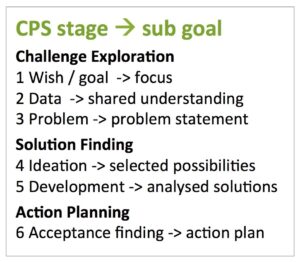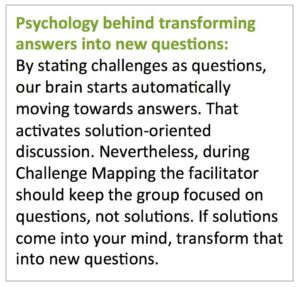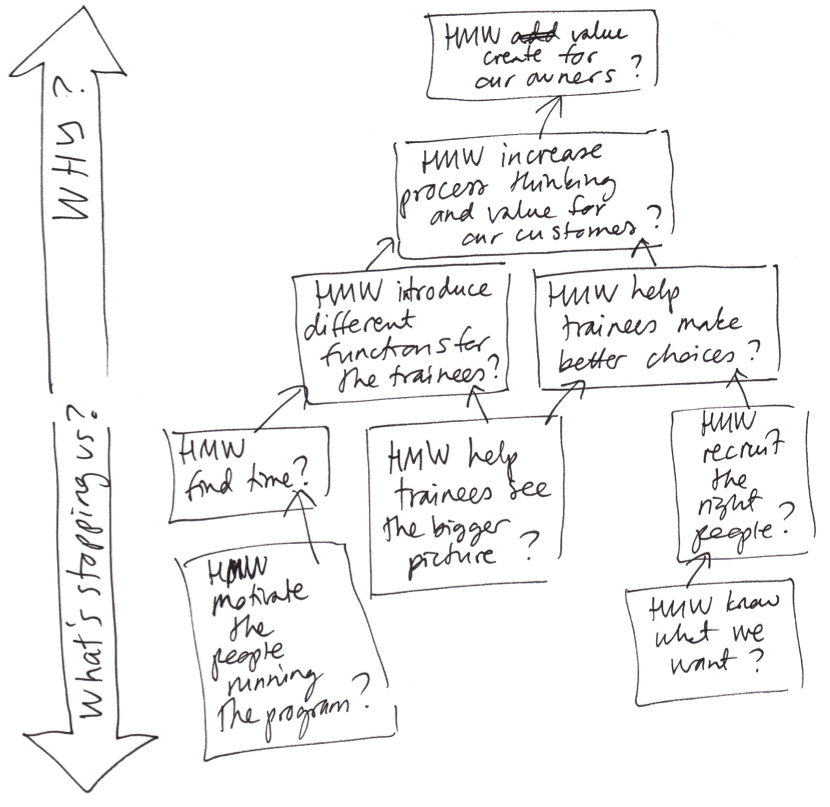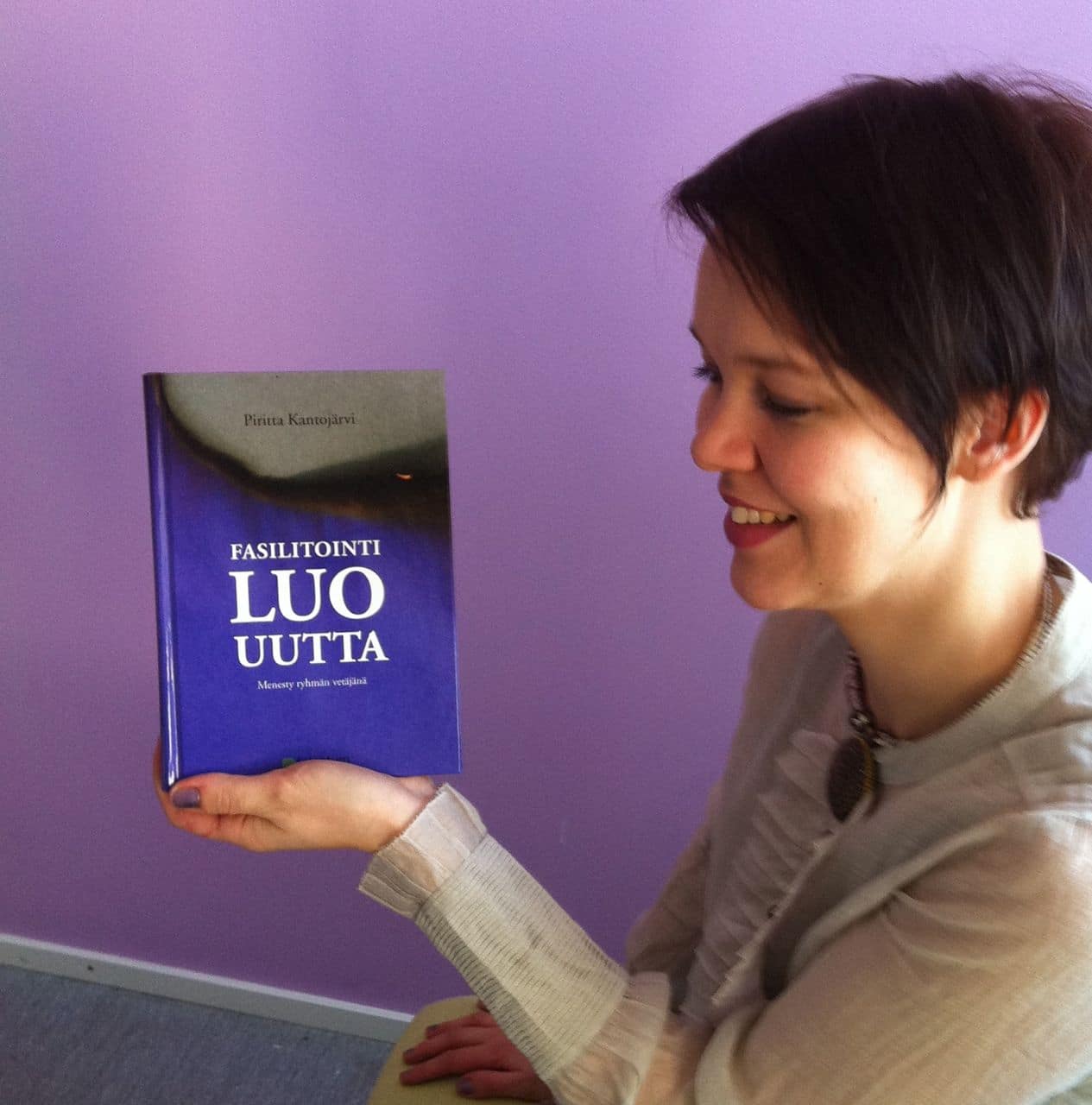Challenge Mapping – a powerful method for finding the right focus

4.4.2017
Issue: In a workshop, people go straight to business without a second thought about “why”
Most people underestimate the importance of the clarification stage.
It happens surprisingly often that innovation and development workshops begin with ideation. The facilitator is given a topic, a question that needs to be answered by the group. In the beginning of the workshop there is an introduction to the topic, then large quantity of wild ideas is produced and the best are ones chosen. As the outcome are great solutions and prioritized action plans, and a motivated group to implement the solutions. Some time later it appears that the actions will not solve the problem. Time, energy and money totally are wasted when the group didn’t begin with the right question. Ever happened to you? The Creative Problem Solving Process begins with Challenge Exploration (CPS, by Osborn & Parnes). It is about creating shared understanding of the objectives, data and problem at hand. In today’s complex world it is often a challenge that we might face in the future, not necessary a clearly defined problem. In either case, a focus is needed: what is the key question in which we’ll need new ideas for? Many times I’ve noticed that only the manager really knows what the challenge is about. Sometimes he doesn’t know it either. From the facilitator it takes a lot of courage to question the topic you’ve been given.
The Creative Problem Solving Process begins with Challenge Exploration (CPS, by Osborn & Parnes). It is about creating shared understanding of the objectives, data and problem at hand. In today’s complex world it is often a challenge that we might face in the future, not necessary a clearly defined problem. In either case, a focus is needed: what is the key question in which we’ll need new ideas for? Many times I’ve noticed that only the manager really knows what the challenge is about. Sometimes he doesn’t know it either. From the facilitator it takes a lot of courage to question the topic you’ve been given.
“Why are we having this workshop?”
Finding the starting point and purpose of a workshop is crucial.
In the middle of the downturn I was asked to facilitate a team integration process. It was a global team, spread in several countries. The director of this team explained to me that 60% of the group is doing job A and 40% job B. To keep the example anonymous, let’s call A software and B hardware. According to the director these teams had nothing in common. Well, he asked me to facilitate the team integration day with an objective of finding shared working principles. I wondered why they needed such if they had nothing in common. Well, after a little hesitation I dared to ask that. The director answered kindly, something that I really didn’t get. So I asked again.
- Piritta: Why do you need shared working principles?
- Director: Well, because we are an integrated team and sometimes we have shared meetings.
- P: Why?
- D: That’s why we need the working principles, to know how to run our shared meetings.
- P: (puzzled) This might be a little provocative, but to me it seems that nobody in this room really knows why these two teams need to be integrated.
- (Silence. )
- D: Well, indeed, this was a decision made somewhere higher up few months ago. I’ve been a director of this team for two months and I have continued as if there were two teams. We haven’t done a single thing to act like one team.
- P: How might the participants feel about this integration?
- D: They hate it! They want to cancel it. It makes no sense for them. They have nothing in common and no interest in each other’s work.
- P: Ok. Thank you for your honesty. Let’s imagine that under these circumstances we gather people together in a workshop and let them brainstorm shared working principles. Let’s imagine they come up with some. What might happen when they get back to their own offices?
- D: (laughing) They’ll continue just like before! Nothing will change.
- P: I’d assume so, too. How might we do things differently?
- D: hmm..
- P: What if we began the day with straightforward honesty, allowing them to figure out themselves: what kind of synergies might they have with each other, why to work together and why not? After all, they are working with the same product, aren’t they?
That’s what we did – we stuck to the transparent attitude for the whole day. Eventually the workshop went well. In the afternoon people worked in mixed small teams out of their own will and curiosity, solving issues across team borders. The point of this story is that it takes courage to clarify the starting point of the workshop and keep asking why. It’s also very powerful. Challenge Mapping is one of the methods that can be used in workshop planning meetings as well as in workshops and coaching sessions to find the right focus.
The Challenge Mapping Method
Where does the Challenge Mapping Method come from?
Years ago I was facilitating a workshop together with Garry van Patter, and I admired his way of helping the customer find the core problem in a rather chaotic situation. I did notice that he used some kind of facilitation method, but I wasn’t able to capture it. Later I learned that the method he had used is Challenge Mapping and that it came from Min Basadur, one of the creativity gurus in the world. I had the honour to spend some time with Min Basadur and learn this powerful method.
The principles are simple, but it requires a variety of other skills to guide the group through it. This is definitely one of the most challenging facilitation tools I have ever seen. Took me years to master it. Now I’m totally passionate about Challenge Mapping and happy to be able to share it with you. The questions in Challenge Mapping are general questions that are commonly used in CPS-processes. The method is described here in a way I’ve successfully used it. It might not be the original Basadur way, neither the only way. At the end of this article you can find a description of a variation: “Challenge Mapping Easy”.
The purpose of Challenge Mapping
- Create a large amount of questions
- Create shared understanding of the challenge, everything related to it, all obstacles and also the greater purpose why problems need to be solved
- Clarify and crystallize the core question(s) which can be used as a starting point for solution finding
Stages of Challenge Mapping and how to facilitate them:
1 . Getting started
Ask participants to empty their minds: On your own, make a list of “How might I/we..” questions about the topic at hand. You can write each question on a post-it.
Ask people to bring their questions on the wall where you’ve created “a parking lot” (=empty flipchart papers).
Pick one question and put it on a large flip chart paper. Ask the participants which one but don’t spend too much time choosing, it doesn’t really matter which one, but it should be something that triggers you all.
 2 . Asking: Why?
2 . Asking: Why?
Ask the group: “Why does this question need to be solved?” Once you get an answer, ask that person transform the answer into a new “How might we..:” question. Make sure that the content doesn’t change.
Example: “We need to solve this because then we could get more people involved à How might we get more people involved? “
Write it on a post it (unless it’s already in the parking lot) and place it above the previous question.
Repeat asking “Why..?” and working upwards. The higher you go, the more abstract it gets and you’ll reach the core purpose / mission. At some point it’s not meaningful to go further up, or if you face any sign of resistance or hesitation, move to stage 3.
3 . Asking: What’s stopping us?
Pick one question on the map based to the previous discussion and ask the group “What’s stopping us to solve this?” Once you get the answer, ask the people to transform that into a new “How might we..” question. Write it o a post-it and place it on below the previous question.
Repeat asking: “What else is stopping us…?”. You can also point out some other question. Keep moving downwards. The lower you go, the more concrete the questions become.
4 . Expanding the map
Keep building the map by picking one question at a time and asking either “Why?” or “What’s stopping us?”. You can build the map horizontally wider by asking “What else…”. This is about mixing the stages 2 and 3.
It the map gets too full and something doesn’t fit in, you can take one question out on a separate flip chart and expand it there, and then bring some kind of conclusion back to the bigger map.
Double-check the connections by asking: “If this question could be solved, might it help us to solve this one?” (point to the one above it) If yes, draw an arrow from bottom up. If the connection is not clear, you might want to ask for obstacles again.
5 . Selection
Ask the group to select the question that unties the knot, question that helps moving forward. There is a variety of methods that you can use at this stage:
- Individual thinking / pair discussion / whole group discussion
- Make a choice based on: is it important, is it interesting, can we influence this, does this require imagination for new ideas
- Dot voting
- Value clock: compare two alternative at a time, which one should be answered first, what’s the root and what’s the cause.
Be aware that making a Challenge Map might have created some new understanding about the topic, which is not presented on any of the post-its on the wall. Just dot voting might not do then. Trust yourself that you’ll know what to do when you are in the situation, as long as you stay alert and present, listening carefully.
Example: Using Challenge Mapping in a discussion
- Customer: I’d like to plan an introduction program for our new employees.
- Piritta: What’s your challenge about this?
- C: How might we help trainees see the bigger picture?
- P: Why is this important?
- C: They would then make better choices.
- P: Could you please transform that into a “How might we..” question?
- C: How might we help trainees make better choices?
- P: Which other reasons are there, why it’s important to help trainees see the bigger picture?
- C: They would need to know all the different functions we have.
- P: How might you formulate that into a new “How might we question..”?
- C: How might we introduce different functions for them?
- P: Why is it important that they know different functions?
- C: It would improve their process thinking and eventually bring more value for our customers.
- P: Could you please state that as a new How might we question?
- C: How might we increase process thinking and value for our customer?
- P: Why is that important?
- C: (laughing) Well, we need to create value for our company owners as well.
- P: Let’s look at the questions here. Is there something stopping us to help trainees making better choices?
- C: Not really, we just need to hire the right people.
- P: So this is about How might we recruit the right people?
- C: Yes.
- P: What’s stopping you to do that?
- C: hmm. Not much, as long as we know what we want, we’ll get the right people. So How might we know what we really want?
- P: Thank you. How about introducing different functions for trainees? What’s stopping us doing that well?
- C: How might we find time?
- P: Why is that difficult?
- C: It’s about the people running the introduction program. How might we motivate them? Yes, that’s it! That’s what this is all about!
 Make no mistake – Challenge Mapping is a difficult method
Make no mistake – Challenge Mapping is a difficult method
This is not an easy method in terms of managing the group dynamics, getting everyone involved, sharing the logic and keeping the focus.
In order to succeed with Challenge Mapping, please consider:
- How to take into account different learning styles in the group?
- How to keep up the group energy?
- How to activate the whole group?
- How to keep the group in the challenge exploration face, not to move into ideas or solutions, yet?
An easier version: Challenge Mapping “Light”
By going through each question at a time and applying the “me-we-us”-method, you can gain some of the benefits of the Challenge Mapping without making it too difficult for yourself. First people think on their own, then in small groups and eventually as the whole group. Keep the diverging and converging separate at all times!
- Why is this topic important? Why do we need to solve this problem? Clarify the purpose.
- What’s stopping us to solve this? Write a list of obstacles and choose the most important ones.
- Based on the previous stages, brainstorm a large quantity of questions that begin “How might we..”. What are all the questions that we should look at in order to fulfil our purpose and tackle all the problems? Select the best questions based on the criteria’s: important, interesting, influence, imagination.
Now it’s your time to go and try it out in practice! Be courageous and remember, that after exploring the challenge properly and finding the right questions, you’ve done more than half of the Creative Problem Solving Process. The rest will not only be easier, but also more efficient, and the whole process has a great possibility of making influential results.
How do I get started?
Where can I apply Challenge Mapping?
- Complex situation that requires clarification
- Participants need to be motivated to go through a demanding development process
- Problem Solving Processes
- Beginning of a strategy creation process
- Beginning of a product development or service design process
- Finding the right direction in a mentoring / coaching session
How could you use Challenge Mapping in your own work (and other areas of life)? Here are three tips that worked well for most people to get started:
1 . Use it on your own. Choose any topic. You might realise that you end up with “what do I wish do with my life” type of questions quite soon. Be aware that this can happen with groups as well, going very deep, almost too personal.
2 . Use it with a friend, who wants to e.g. change jobs or live in a cleaner home.
3 . Use it with a small group, 2-6 people and try out the “Challenge Mapping Easy” version here above.
Would you like to experience how the Challenge Mapping is being used and improve you own facilitation and coaching skills? Check our next public trainings and free demos in Helsinki or contact us, so that we can discuss the possiblities of having a demo or training just for your own organisation.
Can you read Finnish? Here you can find Piritta’s book “Fasilitointi luo uutta” >
Piritta Kantojärvi
CEO Grape People Finland
PIRITTA KANTOJÄRVI IN
@GRAPIRITTA
 Piritta is a certified professional facilitator, who has been working at Grape People since 2007. She is both facilitating workshops and training others to become facilitators. Her special interest are in the clarification of compex topics and creating fresh ideas – often she is asked to come in and help in strategy work, customer experience, team development and innovation processes. She has written a book about the facilitation of creative problem solving in 2012 (in Finnish). By education she is Master of Art.
Piritta is a certified professional facilitator, who has been working at Grape People since 2007. She is both facilitating workshops and training others to become facilitators. Her special interest are in the clarification of compex topics and creating fresh ideas – often she is asked to come in and help in strategy work, customer experience, team development and innovation processes. She has written a book about the facilitation of creative problem solving in 2012 (in Finnish). By education she is Master of Art.
This blog post is edited from an article written by Piritta Kantojärvi 17.10.2011.
Feel free to reach out in case you would like a tailored training
for your team or organization: [email protected].
We are more than happy to help you!


